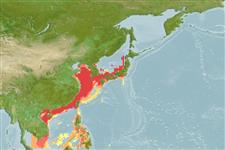Lớp phụ Cá sụn (cá mập và cá đuối) (sharks and rays) >
Orectolobiformes (Carpet sharks) >
Orectolobidae (Carpet or nurse sharks)
Etymology: Orectolobus: orektos (Gr.), stretched out; lobus (L.), from lobos (Gr.), rounded projection or protuberance, referring to long nasal barbels of Squalus barbatus (=O. maculatus). (See ETYFish); japonicus: -icus (L.), belonging to: Japan, described from two specimens, both from Japan. (See ETYFish).
More on author: Regan.
Environment: milieu / climate zone / depth range / distribution range
Sinh thái học
Biển gần đáy; Mức độ sâu 0 - 200 m (Ref. 106604). Tropical; 43°N - 6°N, 103°E - 140°E
Western Pacific: Japan and Korea to Viet Nam.
Length at first maturity / Bộ gần gũi / Khối lượng (Trọng lượng) / Age
Maturity: Lm ?, range 103 - ? cm
Max length : 118 cm TL con đực/không giới tính; (Ref. 106604)
Các tia vây lưng cứng (tổng cộng) : 0; Tia cứng vây hậu môn: 0. Five to six dermal flaps below and in front of eyes; back with light areas between dark saddles marked with broad reticulated dark lines (Ref. 13577). Caudal fin with its upper lobe hardly elevated above the body axis, with a strong terminal lobe and subterminal notch but no ventral lobe (Ref. 13577).
A little-known bottom shark found inshore (Ref. 247); usually in sand or sandy mud bottoms (Ref. 11230); also on rocky and coral reefs (Ref. 43278). Nocturnal in habits (Ref. 247). Feeds on fish and presumably bottom invertebrates (Ref. 247), including lizardfishes, cutlassfish, horse mackerel and other jacks, goatfishes, groupers, tilefishes, sea robins, whiting, parrotfishes, sea bream, croakers, also skates, shark egg cases, cephalopods, and shrimp (Ref. 43278). Ovoviviparous (Ref. 43278, 50449), with up to 20 young in a litter (Ref. 247). Wobbegongs should be regarded as potentially dangerous because of its formidable dentition (Ref. 247, 13577). Used for human consumption (Ref. 247). Kept in aquaria in Japan and the United States (Ref. 43278).
Ovoviviparous, embryos feed solely on yolk (Ref. 50449). With up to 20 young in a litter (Ref. 247).
Compagno, L.J.V., 1984. FAO Species Catalogue. Vol. 4. Sharks of the world. An annotated and illustrated catalogue of shark species known to date. Part 1 - Hexanchiformes to Lamniformes. FAO Fish. Synop. 125(4/1):1-249. Rome, FAO. (Ref. 247)
IUCN Red List Status (Ref. 130435)
Human uses
Các nghề cá: buôn bán nhỏ
Các công cụ
Special reports
Download XML
Các nguồn internet
Estimates based on models
Preferred temperature (Ref.
123201): 14.5 - 27.7, mean 24 °C (based on 222 cells).
Phylogenetic diversity index (Ref.
82804): PD
50 = 0.5012 [Uniqueness, from 0.5 = low to 2.0 = high].
Bayesian length-weight: a=0.00389 (0.00180 - 0.00842), b=3.12 (2.94 - 3.30), in cm total length, based on all LWR estimates for this body shape (Ref.
93245).
Mức dinh dưỡng (Ref.
69278): 3.8 ±0.57 se; based on food items.
Thích nghi nhanh (Ref.
120179): thấp, thời gian nhân đôi của chủng quần tối thiểu là 4.5 - 14 năm (Fec=20).
Fishing Vulnerability (Ref.
59153): High to very high vulnerability (71 of 100).
